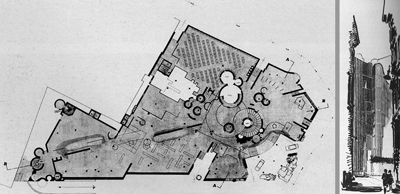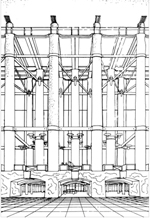You are in: Home page > Magazine Archive > Ludovico Quaroni and the architecture into the city

Paola Scala
Ludovico Quaroni and the architecture into the city
I don’t think I could be accused of excessive optimism if I say that the historical city was beautiful
Ludovico Quaroni
In La Torre di Babele, Quaroni wrote about the beauty as formal outcome of an idea of city that is a collective work of art where the acting of many was composed in an unitary structure, result of a “total composition”. Into the city so intended each building didn’t expect to be independent, a single structure, but each buildings depended on the others and it didn’t expect to be what it was without its relation and the relationship with the others (cf Quaroni, 1966, 64).
These observations perhaps are one of the possible keys to understand the whole work of the Roman architect, not only the projects for the historical centres where the idea of city is already “defined” but also the projects for the today city where the urbanista (that has different skills from the planner) without wasting time on the myth of a city entirely defined in a design-project by a single architect, pursues the general and figurative idea of the formal structure of that part of the city he’s working on (cf Quaroni, 1966, 138). Probably, this point of view allow us to grasp the possible continuity of a never-ending research, that had different outcomes in the projects of Quaroni.
In 1967, on the occasion of the competition for the new office building of "Camera dei Deputati", Quaroni designed a building characterized by a continuous corten façade ploughed by deep millings that underline the axes “obtained” from the context, projecting them into the buildings like blind alleys. Quaroni designed the plan of the building with those four axes, marked by circular forms able to connect, like hinges, the different directions. The whole building suggests the image of a thin baroque machine at genius loci service (cf Ciorra, 1989, 52) in its internal spatiality and in its formal relationship with the city, fixed in perspective views.
Sixteen years later, in 1983, Quaroni designed in Rome the enlargement of the Opera house: a project really different from the building for the Chamber of Deputies. The new Opera house is an hypostyle hall made by 82 columns. The hall is founded on a basement that holds the main entrance for the public and, in the same way, the entrance to the parking lot. A sequence of lowered arches keeps the rhythm of the basement and emphasizes the rush of the pink granite columns that ideally continue the solid parts, stressing the vertical dimension of the façade and avoiding its possible impairment because of the little space between the building and the street. The building takes up the entire plot and builds a new square (piazza) for the city at the second level. The disposition of the columns is in the "quinconce" (staggered rows) way, so the space is more dynamic, inside but above all outside. Also in this project container and contents of a building are two differently defined spaces but they are made by the same design and construction work and so they are intimately related: the building itself defines them and put them in a social and formal relation of congruence and coherence (cf Quaroni, 1977, 73).
The two projects represent two different moments of Quaroni's work; from a figurative point of view the first one is closer to the San Giuliano project, while many critics say that the second project was for Quaroni a way to pacify himself with his beginning: the project for the Imperial square in the E42, a place where he didn't want to come back for many years. But there is something that seems to link strictly the two projects which is the discussion of a theme that goes beyond the simple relationship context-building: the Immagine di Roma (Image of Rome), the title of a memorable book concerning that city which Quaroni was always trying to understand and modify with his projects (cf Purini, 2012, 60).
Bibliography
Quaroni, L. (1966). La Torre di Babele. Padova: Marsilio
Quaroni, L. (1977). Progettare un edificio. Milano:
Mazzotta
Ciorra, P. (1989). Ludovico
Quaroni 1911-1987. Milano: Electa
Purini, F. (2012). Lectio.
Ludovico Quaroni e la Scuola di Roma. In Capozzi, R., Orfeo, C., Visconti,
F. (edited by), Maestri e Scuole di Architettura in Italia. Clean:
Napoli, 49-62.
Paola Scala (1972), PhD in Urban Design and Architectural Composition, is holder of a research contract of the Department of Urban Design and Planning in the University of Naples “Federico II”.















